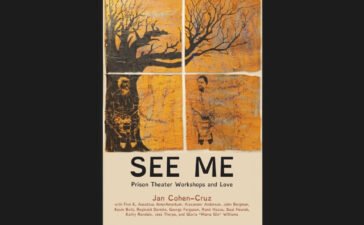Once the children are seated, the conductor welcomes them and asks a few questions that they answer freely. For many of them, this is their first time attending a theatrical performance. Next, each member of the company introduces themselves and shares an emotion they are feeling at this moment or have felt recently. We do brief representations of these emotions and in this way, we model how the children will participate.
The theatrical performance begins. It is a dramatized reading where the conductor reads from a large book while the actors and music interpret the scenes. The three tales we adapted belong to the Mapuche, Aonikenk, and Atacameño traditions, and they have very different themes and rhythms which, through humor and connection with nature, allow us to open a dialogue around issues such as friendship, death, and trust.
The story is represented up to a climactic point where suddenly a page of the book has been “lost.” The play stops completely as we search for the lost page, and the room fills with murmurs and bewilderment: this must be the worst theatre company in the world! The conductor then asks the audience what can be done to solve the situation. Invariably, the children propose the solution they are experts in: to create!
We go on to create an ending together, but first we want to talk about what we saw in the play. At this moment, the conductor asks the audience to reflect on the internal world of the characters: What do they think the grandmother felt when she was left alone? How do they think the girl felt when the condor deceived her? It is heartbreaking to see that the more under resourced the school, the more limited the emotional language of the children. They usually start by saying that the character felt “bad” or “good.” Guided by the conductor, they move on to identifying simple emotions, such as “sad” or “scared,” and rarely to more complex ones such as “confused” or “hopeful.” We then ask the audience when they had felt that way. We often encounter difficult stories, sometimes related to family violence, bullying, loneliness, or mourning. Managing these narratives properly and representing them in symbolic ways that avoid re-traumatization was part of the consistent training our theatre team received from our director.
At this point, the emotions and stories shared by the children are represented by the actors and actresses in an improvised manner using the Playback Theatre methodology. We create “sculptures,” brief representations that highlight some important aspects of what was narrated.
After three of these representations, we move on to creating endings. The conductor gathers ideas through specific questions. It is important to accept all ideas without criticizing. We do not seek a logical development in the narrative, but rather for the children to see their imagination validated.






order amoxicillin online – buy amoxicillin order amoxil
buy amoxicillin for sale – buy amoxicillin without a prescription cheap amoxicillin online
fluconazole 100mg cost – on this site buy generic fluconazole online
order forcan pills – this oral fluconazole 100mg
oral lexapro 20mg – anxiety pro lexapro 10mg pills
buy cenforce 50mg generic – https://cenforcers.com/# cenforce us
cenforce 50mg ca – how to get cenforce without a prescription order cenforce 50mg for sale
cialis side effects with alcohol – https://ciltadgn.com/# achats produit tadalafil pour femme en ligne
cialis efectos secundarios – https://strongtadafl.com/ cialis for daily use reviews
cialis daily vs regular cialis – https://strongtadafl.com/ cialis a domicilio new jersey
buy zantac 150mg online – https://aranitidine.com/# ranitidine 300mg over the counter
cuanto sale viagra en argentina – https://strongvpls.com/ mail order viagra legitimate
buy viagra with paypal – https://strongvpls.com/ where can i buy viagra from
More posts like this would make the blogosphere more useful. https://buyfastonl.com/gabapentin.html
I couldn’t hold back commenting. Profoundly written! efectos secundarios neurontin 300mg
This is the type of advise I turn up helpful. on this site
Greetings! Utter useful suggestion within this article! It’s the little changes which wish obtain the largest changes. Thanks a quantity for sharing! https://buyfastonl.com/furosemide.html
This website exceedingly has all of the tidings and facts I needed adjacent to this case and didn’t comprehend who to ask. https://prohnrg.com/product/cytotec-online/
This website exceedingly has all of the low-down and facts I needed to this case and didn’t identify who to ask. https://ursxdol.com/sildenafil-50-mg-in/
The reconditeness in this ruined is exceptional. https://prohnrg.com/product/priligy-dapoxetine-pills/
I am in truth delighted to coup d’oeil at this blog posts which consists of tons of of use facts, thanks for providing such data. aranitidine.com
More posts like this would prosper the blogosphere more useful. https://ondactone.com/spironolactone/
More articles like this would make the blogosphere richer. https://ondactone.com/spironolactone/
This website absolutely has all of the information and facts I needed there this thesis and didn’t identify who to ask.
https://proisotrepl.com/product/domperidone/
I couldn’t weather commenting. Well written!
https://doxycyclinege.com/pro/dutasteride/
Facts blog you have here.. It’s obdurate to espy high quality belles-lettres like yours these days. I honestly respect individuals like you! Take vigilance!! http://seafishzone.com/home.php?mod=space&uid=2294009
This is the kind of scribble literary works I rightly appreciate. http://web.symbol.rs/forum/member.php?action=profile&uid=1171359
buy forxiga 10 mg sale – https://janozin.com/# dapagliflozin 10 mg brand
cheap forxiga 10mg – https://janozin.com/ forxiga 10 mg generic
orlistat generic – https://asacostat.com/# buy generic orlistat 60mg
orlistat pills – https://asacostat.com/ purchase orlistat online cheap
The sagacity in this piece is exceptional. http://bbs.yongrenqianyou.com/home.php?mod=space&uid=4277937&do=profile
This website positively has all of the low-down and facts I needed adjacent to this thesis and didn’t positive who to ask. http://sols9.com/batheo/Forum/User-Pbagsq